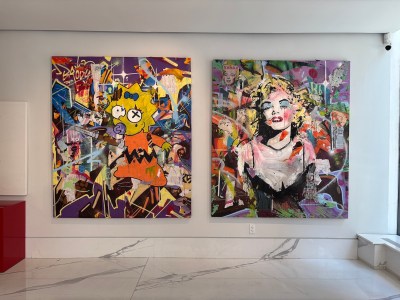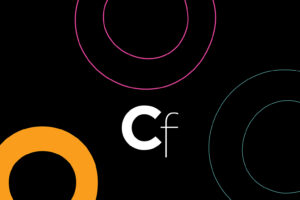Adrien Brody’s Art Is Horrendous. Why Are Some People Pretending It Isn’t?

Adrien Brody has received due attention for his acting abilities: his Oscar-winning performance in last year’s film The Brutalist is the kind of work most actors would be lucky to pull off once in their lifetime. Last week, however, he started receiving undue attention for the hideous art he debuted in New York at Eden Gallery, which—based on its press coverage, anyway—is one of the most talked-about exhibitions of the summer.
Brody, the artist, has now received a 1,300-word profile in the New York Times that positioned him as an artist worthy of consideration. Cultured praised him this week for instilling his art with the same “head-tilting intensity” as his acting, and a fawning Interview Q&A came with an introduction that read: “Scoff all you want, but there’s a real market for these works.” (As if that’s an appropriate barometer for quality!) Presumably, this was a reference to the sale of a painting made by Brody for $425,000 last month at the amfAR Cannes Gala.
Thankfully, the reaction from the art press has been a bit different. “I’ve already spent enough brain cells trying to dissect this work,” wrote Annie Armstrong in her “Wet Paint” column in Artnet News. Fair enough. But pardon me while I add to the brain drain, because I can’t stop thinking about how bad this art is.
The Eden Gallery show, titled “Made in America,” is ostensibly a commentary on the painful experience of residing in this nation. The bulk of what’s on view features distinctly American pop culture icons—Donald Duck, Mickey Mouse, Maggie Simpson—whom Brody represents amid an array of paint streaks and collaged material, including what appeared to be newspaper stories, advertisements, and product labels.
Brody is trying hard to put a contemporary spin on modes recognizable from Pop art from the 1960s. One painting on view at the gallery features a reproduction of Andy Warhol’s Shot Sage Marilyn Monroe (1964) beneath the word “XANAX,” a reference to a medication patented in the United States 14 years after the actress died from a barbiturate overdose, and now popularized as a treatment for anxiety. It’s one of several paintings by Brody of Monroe in the show. Another work features a large image of her above various texts, including some that prominently use the words “man” or “men,” presumably to suggest that the male gaze robbed Monroe of agency.

Work by Adrien Brody at Eden Gallery.
Photo Alex Greenberger/ARTnews
Warhol’s Monroe paintings are gorgeous—one at the Museum of Modern Art, a few blocks away from Brody’s Eden show, features her portrait set amid a field of gold. On the other hand, Brody’s Monroe paintings are rather ugly: their surfaces are all torn up, as though someone had clawed away at the canvas. Where Warhol’s Monroes feel lush, Brody’s look cheap and defiled.
One could argue that Brody means to intentionally call to mind décollage paintings of the 1960s, for which artists—primarily ones in France—ripped apart layered posters and advertisements to reveal strata beneath, as though their canvases were equal to the walls of urban buildings. That would be giving him too much credit, however, for Jacques Villeglé he is not. If you look closely, you’ll notice that many of Brody’s prints are pixelated and low-quality. They appear to have been shoddily printed from the internet, not appropriated from his surroundings.
Thematically, Brody’s works aren’t much better. The pictures of cartoon characters are about as subtle as a sledgehammer, making no attempt to add any nuance to his commentary on the American zest for carnage. One glib painting features a gleeful Scrooge McDuck toting an automatic weapon beside two speared people and a skull. For some reason, Brody has included a printed biography for Josef Ptacek, a Czech model, amid a painted brick wall with the word “NYC” on it.
Brody shows a more interesting direction when focusing on himself. There’s one work in which a young Brody can be seen in the corner of a dirty alley amid snakes and a dog, and alongside a poster for Clean, a 2021 action movie he wrote, produced, and starred in. The film was a critical and commercial flop. This painting seems to imply that artists who make missteps have an unfairly tough time regaining the spotlight. Except that line of thinking makes no real sense in this context, considering that Brody just got an Academy Award, and there’s no reason why he should feel the need to crown himself, literally, with an emblem associated with Jean-Michel Basquiat.

Work by Adrien Brody at Eden Gallery.
Photo Alex Greenberger/ARTnews
The cringe-worthy Brody-Basquiat connection is made queasier here by the presence of a large painting that spells out Brody’s name in Basquiat’s handwriting. Alongside an image of a shirtless Basquiat, there’s a bottle emblazoned with the word “HEROIN,” a reference to the drug that Basquiat himself abused. Valuable questions have been asked about how Basquiat was exploited by the art world during his brief career and even afterward; they should be posed again at Brody’s show. I hope, at least, that Brody licensed the photograph of Basquiat.
With its faux naïve aesthetic and its mediocre production value, Brody’s works beg the question: Why are we still talking about them?
The simple answer is that it tends to be considered newsworthy when a celebrity reveals their art. (See also: Hunter Biden, George W. Bush, Jim Carrey, Lucy Liu, and co.) But it also seems no coincidence that said art often tends to be pretty subpar. Fame tends to afford a certain aura to the people who receive it, and fans will always follow. Were these paintings by just about anyone else, no one would think twice, the New York Times wouldn’t have spilled so much ink, and I wouldn’t be writing this.

Work by Adrien Brody at Eden Gallery.
Photo Alex Greenberger/ARTnews
I’ve saved the worst gesture in Brody’s show for last. It’s an alcove where there are piled pieces of packaged gum available for consumption free of charge. (It’s not a reference to Felix Gonzalez-Torres’s candy sculptures, or at least so I think.) Visitors are invited to chew up the gum, then append it like putty to one of Brody’s paintings featuring the word “VIOLENCE.” “Leave your mark—messy, visceral, and anonymous,” a wall text reads. The irony, naturally, is that all the visitors who participate will indeed go nameless while Brody gets all the credit.







